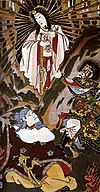Keijō Shrine
| Keijō Shrine | |
|---|---|
 Part of the shrine complex | |
| Religion | |
| Affiliation | Shinto |
| Deity | Amaterasu, Three Pioneer Kami (開拓三神, Kaitaku Sanjin) Ōkunitama, Ōkuninushi, and Sukunahikona, Dangun? |
| Location | |
| Municipality | Keijō |
| Country | Korea, Empire of Japan |
| Geographic coordinates | 37°33′25″N 126°59′11″E / 37.5569°N 126.9864°E |
| Architecture | |
| Date established | November 3, 1898 |
| Destroyed | November 17, 1945 |
 Location relative to present-day Seoul Location relative to present-day Seoul | |
Keijō Shrine (京城神社, Keijō-jinja, Korean: 경성신사), sometimes Seoul Shrine,[1]: 65 [2]: 139 was a Shinto shrine in Keijō (Seoul), Korea, Empire of Japan. The shrine was established on November 3, 1898,[3][4] and destroyed on November 17, 1945, several months after the end of colonial rule.[5]
The shrine was located to the north of the mountain Namsan.
Theological history
[edit]Initially the shrine only worshipped Amaterasu but it later added the Three Pioneer Kami (開拓三神, Kaitaku Sanjin) Ōkunitama, Ōkuninushi, and Sukunahikona used in Japanese colonial shrines. after it was established that it would not become the Chosen Jingu.[2]: 140
Uniquely it referred to Kunitama as Chosen Kunitama suggesting a distinctly Korean flavor, as this shrine attempted to integrate many Korean customs.[2]: 140 Many locals identified "Chosen Kunitama" with Dangun.[2]: 140
In 1936 the government released a memo saying that Okunitama was in fact a generic title for any Korean deity and not Dangun. The name was also changed to Kunitama-no-Okami as a parallel to Amaterasu Omikami[2]: 140
Gallery
[edit]-
A building in the shrine complex dedicated to Japanese General Nogi Maresuke.[6]
-
Torii
-
Honden
-
Interior
-
Pavilion
-
Torii
-
Entrance statues
References
[edit]- ^ Henry, Todd (2014). Assimilating Seoul: Japanese Rule and the Politics of Public Space in Colonial Korea, 1910–1945. University of California Press. ISBN 9780520958418.
- ^ a b c d e Shimizu, Karli; Rambelli, Fabio (2022-10-06). Overseas Shinto Shrines: Religion, Secularity and the Japanese Empire. London New York (N.Y.) Oxford: Bloomsbury Academic. ISBN 978-1-350-23498-7.
- ^ 青井哲人「ソウル・南山の神域化-植民都市と神社境内」(明治聖徳記念学会紀要復刊第43号、2006年)
- ^ 「神社祭神並創立調査表」 JACAR(アジア歴史資料センター) Ref.A03010213400 (国立公文書館)
- ^ 内務省告示第264号 官報第5660号(昭和20年11月22日) 1頁
- ^ 정, 용부 (2018-02-02). "[다크 헤리티지를 찾아서] 서울미래유산에 남겨진 일제 신사의 유구". The Financial News (in Korean). Retrieved 2024-03-11.










